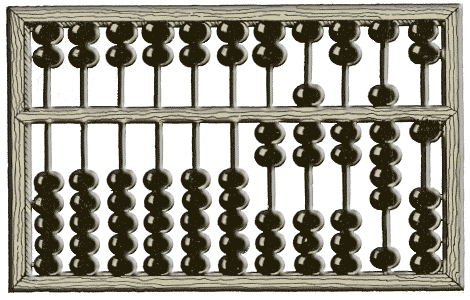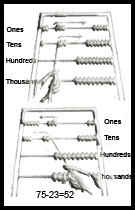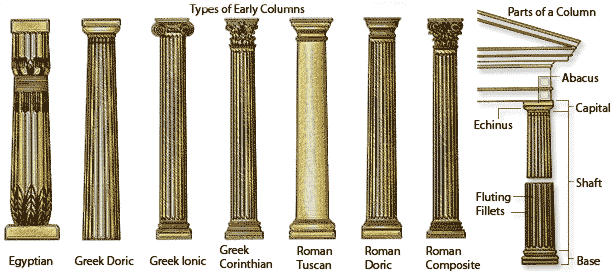Abacus, pronounced AB uh kuhs from the Greek abax, calculating table and manual device which was used in the Oriental during ancient and midiaeval times, and by other ancient people such as the Egyptians, Greeks, Romans and Japanese to perform arithmetic problems. It can be used to add, subtract, multiply, and divide, and to calculate square roots and cube roots. The abacus consists of a frame containing columns of beads. The beads, representing numberic values, are strung on wires or wooden rods attached to the frame.

Abacus
A Chinese bookkeeper using an abacus to calculate for his accounts
Source: Modified from original by Pan American World Airways, Funk and Wagnalls Encyclopedia, ©1950
The Chinese abacus is called suanpan, which means counting, or reckoning, board. A typical Chinese abacus has columns of beads separated by a crossbar. Each column has two beads above the crossbar and five below it. Each upper bead represents five units, and each lower bead equals one unit.

Abacus
Chinese Abacus
Counting is from the right, starting with units or the ones column, followed by the second column which represents the tens column. Third column represents hundreds, and fourth represents thousands. The ones column represents numbers from one to nine. Each bead below the crossbar has a value of one (or one), and each bead above the crossbar has a value of five ones (or five). The tens column represents numbers from ten to ninety. Each lower bead in the tens column represents one ten (or ten), and each upper bead represents five tens (or fifty). A skilled person can make computations with amazing speed. In 1947, one contest in Tokyo placed a skilled abacus operator against an electric computer. The abacus won in problems solving addition and subtraction, likely because much of the computing is done mentally and not recorded using the beads.

Chinese Abacus
A counter moved up represents one, a counter moved down from the upper group counts as five.
The example shown represents a sum of 27,291.
Architecture
In architecture, an abacus (from the Greek abax, a slab; or French abaque, tailloir) is a level tablet of variegated shape, placed on the capital of a column supporting the superstructure. Its chief function is to provide a large supporting surface (wider than the capital) to receive the weight of the arch or the architrave above.
The Doric column is the oldest of the three types of columns and contained no base. It was developed primarily on the western colonies of Greece's mainland. Normally, the shaft is tapered upward to a height of five to seven times the lower diameter. Along the shaft, several vertical grooves (or flutes) meet in sharp ridges. Horizontal grooves (necking), mark where the shaft and the capital meet. A capital is comprised of two parts of nearly equal thickness. The Abacus is a flat square block resting on a round tablet known as the echinus. One building which implements the Doric style column in its architecture, is the Parthenon.

Individual sections of the column and as constructed by ancient Egyptians, Greeks and Romans.
Column is defined as a vertical support beam which is consistuted of a shaft, capital and rests on a base. The ancient Egyptians, Greeks, and Romans had an important influence on later architecture.
Source: Original by World Book Encyclopedia ©2002 by Sarah Woodward
Ionic columns are more slender and decorative in their style, than the Doric. It was created by the Greek architects in the Aegean Islands and Asia Minor. Ionic shafts stand on a circular base, sometimes including a plinth (square block at the bottom). The height usually measures nine to ten times the lower diameter. Typically, twenty four flutes run along the shaft. Its capital consists of volutes separating the echinus from the abacus. The Erechtheum at Athens has columns of Ionic stylization.
Corinthian columns are the most ornamental of the Greek styles. It is a variation on the Ionic style, but with a similar fluted shaft, and more elaborate capital. Its capital consists of a central core which resembles an inverted bell. The core is encircles by carvings of acanthus leaves arranged in rows, and from the leaves four volutes adjoin the corners of the abacus. Corinthian columns can be found on the Athenian monument of Lysikrates.
The ancient Romans adapted their design on the Greeks, and created the Tuscan and the Composite styles. Roman Doric favors the Greek but with addition of a simple molded base. Tuscan style resembles the Doric but without flutes. Composite style is a combination of features from the Ionic and Corinthian.
Roman sculptors also erected columns in memorial of famous people and events, and decorating many of these towering columns with molded spiraling bands (friezes) portraying events related to the memorial. Trajan's Column in Rome is such an example.
During the early Christian and medieval era architects adapted from earlier classical styles for use in basilicas and cloisters. An example of combination of classical and medieval styles is in the Cathedral of Notre Dame in Paris. Use of Roman-style columns was revived in the Renaissance and baroque periods (the colonnades of St. Peter's Square in Rome is an example).
References
- Arthur Gittleman, Ph.D., Professor of Mathematics and Computer Science, California State University, Long Beach
- World Book Encyclopedia ©2002
- Funk and Wagnalls Encyclopedia ©1950
- Colliers Encyclopedia, ©1960
